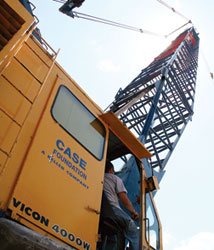 Tudor Van Hampton/ENR Old friction rigs are still in demand.
|
The safety and skill required to operate crawler cranes has evolved from coordinating clutch levers and brake pedals to managing computer buttons and joysticks. While the physical wear and tear is getting easier, the mental load can be demanding.
Operating old, friction-style cranes by “feel,” though not condoned by manufacturers, is still common in the field due to the cranes’ overengineered structures. “This machine has the life beat out of it, and it still acts new,” says Joe Ahern, who muscles a 35-year-old Manitowoc 4000W for Roselle, Ill.-based Case Foundation Co.
Mechanical rigs, designed years before computer modeling was mainstream, are now discontinued from regular production. Their heavy, mechanical drivetrains and lattice booms were designed to withstand tipping over—the crude design tools of the day made the point of structural failure hard to predict.
 Ahern
|
Economics were their undoing. Hydrostatic drives that needed far less heavy gearing made big crawler cranes lighter, cheaper and faster to build and transport.
The trade-off is that a modern rig “can only take so much,” Ahern says. Lighter materials, rated for a bending moment, are married to electrohydraulic controls, effectively turning operation into a high-pressure video game. Gone are the “seat of the pants” sensations, replaced with electronic buzzers and joystick tell-tales.
Some crane experts believe that friction operators are inherently safer, but most agree that it all comes down to individual skill. “There are few shortcuts for training and experience,” explains Ron Schad, president of Buffalo Grove, Ill.-based Essex Crane Rental Corp. Simply pulling levers or pushing buttons “is not operating,” he says. One also must be well versed enough to avoid jobsite dangers—planned or unplanned.
|
Friction cranes and their operators have become a kind of pedigree, and the appeal of robust structure, fast line speed and easy maintenance has made some old rigs just as pricey as new ones. Emission cuts may send many old machines to the boneyard, but replacing an engine in a $1-million crawler crane is a small cost compared to the structure. As a result, mechanical rigs may crawl the Earth for another 20 or more years.
 Tudor Van Hampton/ENR In this cab, comfort is a luxury.
|
For heavy jobs, such as drilling and dredging, the extra sturdiness makes them choice workhorses. New, high-horsepower cranes are starting to compete with the seniors, but the turnover will take time. Older rigs still make up more than one-fifth of all crawler cranes, according to Stuart Anderson, an analyst who runs Chortsey Barr Associates in Hagerstown, Md.
There’s one catch: Who wants to run an old, back-breaking crane? Employers and unions say they are attracting young blood with more pay. Even so, Anderson says that friction operators “are dying out quicker than the cranes.”
 Related Links:
Related Links: 